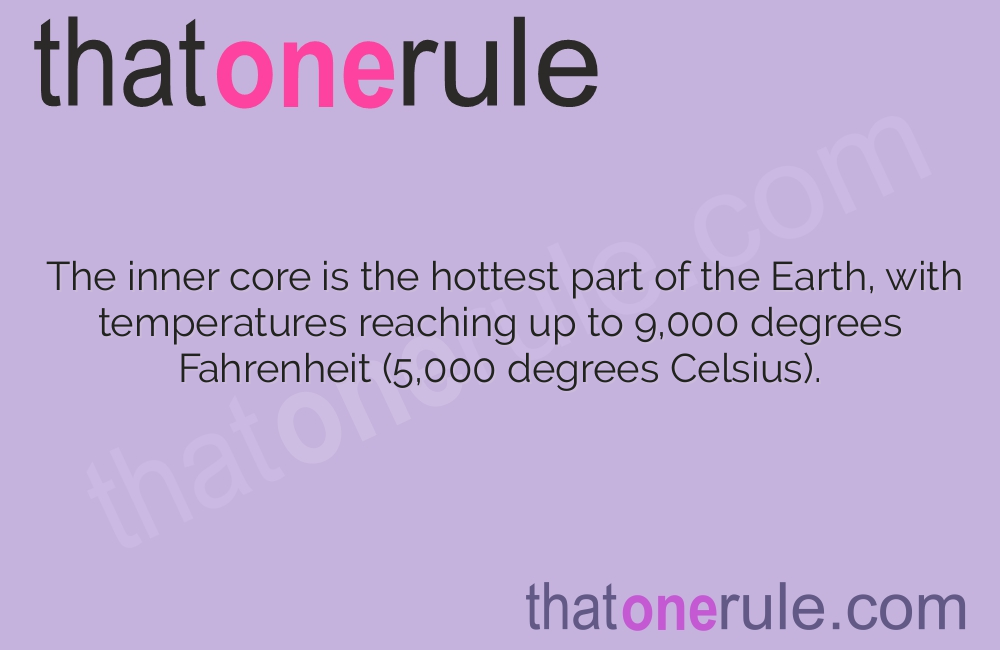Unveiling the Secrets of the Inner Core

The inner core is the hottest part of the Earth, with temperatures reaching up to 9,000 degrees Fahrenheit (5,000 degrees Celsius).
It is made primarily of solid iron and nickel.
The inner core is about 760 miles (1,220 kilometers) in diameter.
The immense pressure in the inner core keeps it solid, despite its extreme temperatures.
The inner core spins at a slightly faster rate than the rest of the Earth, completing a rotation about 0.3 to 0.5 seconds faster per day.
It is located at the center of the Earth, beneath the outer core and mantle.
The inner core is thought to have formed around 1 to 1.5 billion years ago.
Scientists believe that the solid inner core helps generate the Earth’s magnetic field.
The inner core is thought to be responsible for the Earth’s axial tilt, which causes our seasons and climate variations.
Its extreme heat and pressure play a significant role in the movement of tectonic plates on the Earth’s surface.
The inner core is not directly accessible to scientists, so most of our knowledge about it comes from studying seismic waves.
It is solid because the pressure prevents the iron and nickel from melting, even though they would typically be in a liquid state due to the intense heat.
The inner core was discovered in 1936 by the Danish seismologist Inge Lehmann.
The diameter of the inner core is approximately 70% of the Moon’s diameter.
Unveiling the Secrets of the Inner Core part 2
The inner core experiences a continuous increase in size as the outer core slowly solidifies.
Scientists theorize that the inner core’s solidification rate is approximately 1 millimeter per year.
Earth’s inner core is vastly different from the cores of other planets in our solar system.
The inner core is geologically distinct from the outer core, despite both being composed of iron and nickel.
The exact boundary between the inner and outer core is still not fully understood by scientists.
The inner core does not emit light or heat because it is not in direct contact with Earth’s surface.
The inner core’s immense pressure causes the iron and nickel to compress into a denser state.
Scientists believe that the inner core’s rotation affects the Earth’s overall rotation and the length of a day.
If the inner core were not spinning, Earth’s rotation would gradually slow down over time.
The inner core provides stability to Earth’s magnetic field by acting as a dynamo or generator.
The inner core’s existence was initially hypothesized based on observed changes in seismic wave velocities.
The inner core’s solid state also plays a role in protecting the Earth’s surface from harmful solar radiation.
The inner core’s solidification rate might have slowed down over time due to changes in heat flow from the outer core.
The inner core is positioned at the same latitude as the Tropic of Capricorn.
Scientists estimate the inner core to be around 3.3 to 3.7 billion years old.
The inner core’s rotational speed has been measured by comparing seismic data from earthquakes around the world.
The inner core is not perfectly spherical in shape, but instead has minor deformations caused by various factors.
The inner core’s density is approximately 12.8 g/cm3, which is about three times denser than the outer core.
The inner core experiences plastic deformation due to the immense pressure and temperature.
The inner core’s solidification process might lead to phase transitions, similar to how water transitions from solid to liquid to gas.
The inner core’s iron composition is believed to have originated from the debris left by the collision of smaller bodies during Earth’s formation.
The inner core’s intense pressure creates an environment where iron atoms tightly pack, resulting in a solid state.
The inner core’s magnetic field likely has a significant influence on the overall dynamics of Earth’s magnetic field.
The inner core’s rotation speed is not constant and might experience periodic changes over long periods.
The inner core’s temperature gradient is steeper at the outer boundary, gradually decreasing towards the center.
Scientists have developed models to simulate the inner core’s behavior and study its various aspects.
The inner core’s growth rate is influenced by the heat released from the freezing of the outer core.
The inner core’s composition might not be uniform, with different regions having slight variations in iron and nickel content.
The inner core’s solidification allows for the release of latent heat, helping to drive convection in the outer core.
The inner core’s solid state provides stability to support the weight of the rest of the Earth’s layers.
The inner core’s significance in Earth’s geodynamic processes continues to be a subject of ongoing research and exploration.